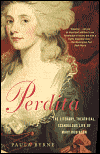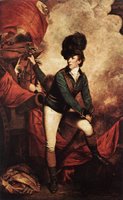 A few months ago I blogged about a biography of Harriet Wilson that I was reading on my commute to work. My latest tart-on-the-tracks experience was with this biography of Mary Robinson by Paula Byrne–Perdita: The Literary, Theatrical, Scandalous Life of Mary Robinson.
A few months ago I blogged about a biography of Harriet Wilson that I was reading on my commute to work. My latest tart-on-the-tracks experience was with this biography of Mary Robinson by Paula Byrne–Perdita: The Literary, Theatrical, Scandalous Life of Mary Robinson.
It’s a pretty good biography, but you don’t get a sense of who Mary Robinson really was. There’s something enigmatic about her–she did an excellent cover-up job with the media and with her own writing. Even her biography is, acccording to Ms. Byrne, fairly typical for its time, full of omissions and inventions, always anxious to appear a nice, respectable girl. First and foremost an actress, she was adept at assuming roles–as a leader of fashion, a woman of politics (Fox was her lover for a time), an abandoned waif, child bride, tragic heroine. She began her theatrical career as a protegee of Garrick (although she probably wasn’t his mistress), before attracting the attention of the youthful Prince of Wales. He became besotted with her in the role of Perdita in The Winter’s Tale, referring to himself as Florizel, when she was a lovely young thing of 20 or 21, and he was as much of a lovely young thing as he was ever going to be at the age of 17.
 The other love of her life was Colonel Banastre Tarleton, a hero of the American Revolutionary Wars, and not a particularly pleasant person (his nickname over here was “Butcher,” a dead give away). But there must have been something about him (maybe it was his third arm as the portrait suggests)–their affair lasted for years, with Mary, ever the publicity hound, submitting sentimental poems to newspapers at each breakup and reconciliation. They were the Posh and Becks, the Jennifer and Brad of their time, adored, imitated, extravagant leaders of fashion. Politically they were at opposite ends of the spectrum. She was a supporter of the abolitionist movement and in sympathy with the French revolution; Tarleton came from a rich Liverpool family and was pro-slavery and old school; nevertheless Mary wrote (some of) his political speeches and they co-authored a book together about his military experiences. I can’t help but think of Mary leaning over his shoulder correcting his spelling while he writes with his lips moving.
The other love of her life was Colonel Banastre Tarleton, a hero of the American Revolutionary Wars, and not a particularly pleasant person (his nickname over here was “Butcher,” a dead give away). But there must have been something about him (maybe it was his third arm as the portrait suggests)–their affair lasted for years, with Mary, ever the publicity hound, submitting sentimental poems to newspapers at each breakup and reconciliation. They were the Posh and Becks, the Jennifer and Brad of their time, adored, imitated, extravagant leaders of fashion. Politically they were at opposite ends of the spectrum. She was a supporter of the abolitionist movement and in sympathy with the French revolution; Tarleton came from a rich Liverpool family and was pro-slavery and old school; nevertheless Mary wrote (some of) his political speeches and they co-authored a book together about his military experiences. I can’t help but think of Mary leaning over his shoulder correcting his spelling while he writes with his lips moving.
She gave up her stage career at the request of the Prince of Wales, who proved unreliable thereafter in his annuity payments, and after illness and disability from rheumatic fever ended her career as a courtesan, earned her living writing poetry and novels. Godwin and Coleridge were her friends and admired her work. She was rediscovered in academic circles in the 1990s though I have to admit the poetry copiously quoted in Ms. Byrne’s biography left me cold and/or slightly cringing at its sprightly archness.
I must admit she didn’t appeal to me as much as Harriet Wilson, but I enjoyed this biography–there are some great descriptions of clothes and of late eighteenth-century London; it’s just a pity that Mary is presented mostly as a series of public personae. And that’s the way she would have liked it…here’s to you, Mrs. Robinson…

Thanks for the review, Janet! I have the book but haven’t read it. (That’s a sentence I say a lot.)
BTW, I think his third arm actually belongs to a boy standing behind him. 🙂
Cara
I have to admire these women who survive on their wits, even if their main attraction is their feminine allure. It does seem, though, that their fortunes wane when their beauty fades and the men who professed to love them desert them. I like that Elizabeth Armistead, Fox’s mistress then wife, managed to survive a bit better.
one thing I found very puzzling in this book–and maybe this is something one of you Regency geeks can clarify–is that when Mrs. R and the Prince broke up, he gave her a note for L20,000 (a huge amount of money), payable when he reached his majority. She was, as usual, in dire financial straits and I couldn’t understand why she didn’t sell the note for its face value or best offer. She wasn’t planning to blackmail him as Harriet Wilson did, altho she spent quite a lot of effort on making life uncomfortable for him in other ways.
Also in this bio–unless I’m a careless reader, which is quite likely–we never do find out what happened to Mr. Robinson.
Janet
Janet, about the Paula Byrne bio of Mary Robinson… I have to say that I preferred Hester Davenport’s The Prince’s Mistress — which came out before Byrne’s — over it. Not that Byrne did not do a good, professional job, but I found, personally, that Davenport’s was a lot more readable and enjoyable. I have not yet read the third bio of Robinson that followed these two — by Sarah Gristwood? — so can’t comment on this.
I don’t believe that Mary Robinson got a note from Prinny for that money, just a promise in a letter.
Ban Tarleton was a real rotter, a user and abuser. Mr. Robinson, I think, ran off with another woman. Don’t remember if he predeceased Mary. Never supported their one surviving daughter. Another rotter.
Jo Manning
Janet, about the Paula Byrne bio of Mary Robinson… I have to say that I preferred Hester Davenport’s The Prince’s Mistress — which came out first — over it. Not that Byrne did not do a good, professional job, but I found, personally, that Davenport’s was a lot more readable and enjoyable. I have not yet read the third bio of Robinson that followed these two — by Sarah Gristwood? — so can’t comment on this.
I don’t believe that Mary Robinson got a note from Prinny for that money, just a promise in a letter.
Ban Tarleton was a real rotter, a user and abuser. Mr. Robinson, I think, ran off with another woman. Don’t remember if he predeceased Mary. Never supported their one surviving daughter. Another rotter.
Jo Manning
Tarleton was quite a brutal character–not uncommon for a cavalryman, despite their noble reputation–though he was not quite as bad as the character based on him in the movie The Patriot. But whatever you may say about his moral character, he had excellent taste in headwear.
Todd-who-is-currently-planning-his-own-scandalous-memoirs-but-first-has-to-do-something-scandalous